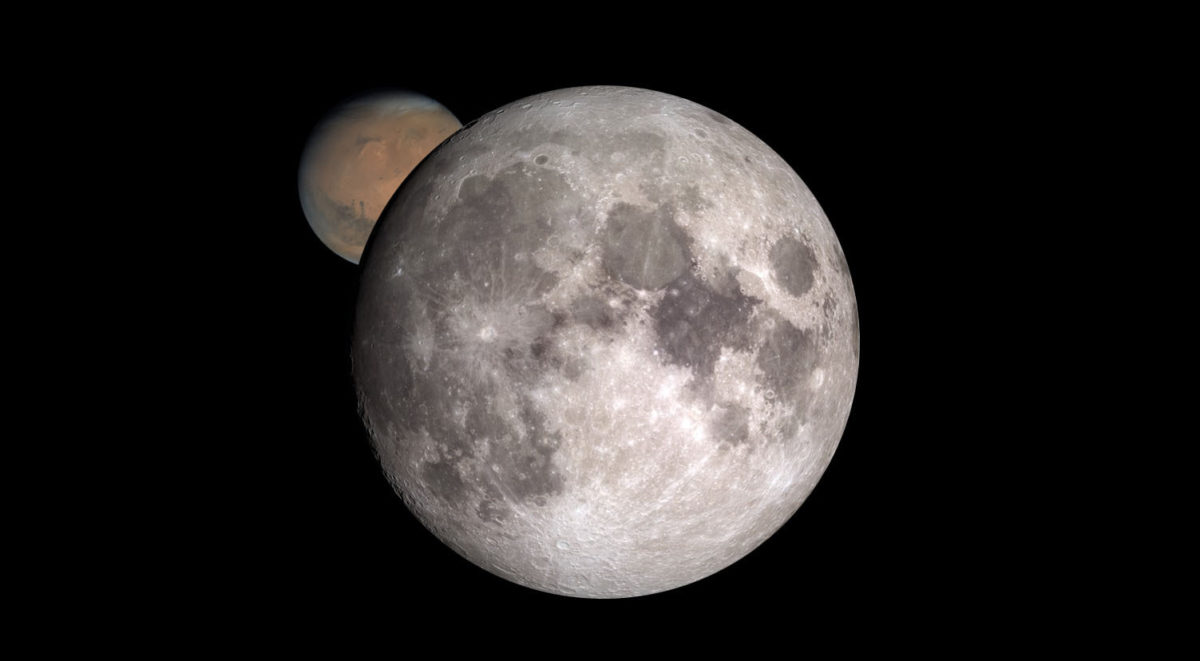Jason Davis • Jan 26, 2017
Let's talk about this whole Moon vs. Mars thing for human spaceflight
In case you haven't heard, the Trump administration may direct NASA to land humans on the moon.
At least, that's according to scattered media reports; officially, NASA remains on course for a Mars landing in the 2030s. Starting with the scheduled inaugural launch of the Space Launch System with Orion late next year, the agency plans to start establishing a human presence in lunar orbit, using it as a proving ground to prepare for deep-space missions to Mars.
Landing on the Moon's surface currently isn't part of that plan. Should that change?

The science
It only takes a glance at a planetary exploration roadmap to see Mars is currently one of humanity's leading targets of interest. There are eight spacecraft operating on or around Mars; five belong to NASA.
Following the loss of the Mars Observer spacecraft in 1993, NASA established the Mars Exploration Program, a systematic series of missions to determine whether Mars "was, is, or can be, a habitable world," and to pave the way for eventual human exploration. The program has been wildly successful; in 2013, drill samples analyzed by the Curiosity rover confirmed the answer to the "was" question is yes.
Whether or not life actually existed there—or still does—will be harder to answer. Back in late 2014, Ellen Stofan, who served as NASA's chief scientist for three years, told me the question would be best solved by astronauts.
"I have a bias as a field geologist that it's going to take astrobiologists, geologists, and chemists on the surface of Mars, being able to go out and read the landscape, pick up rocks, and take them into a lab, to really resolve the question of whether life arose on Mars," she said.
NASA's Opportunity rover has been exploring the surface for 13 years. Mike Seibert, an Opportunity driver and a lead spacecraft systems engineer at NASA's Jet Propulsion Laboratory, said a big advantage of humans over rovers is their ability to improvise quickly. An example of this, he told me, was a meteorite Opportunity inadvertently discovered while the rover was driving between two waypoints.
"We were taking pictures behind us just to record and document, and we downlinked them several sols (Mars days) later," he said. "A half-kilometer down the road, we saw an image of a meteorite. So we doubled back to go see it."
Astronauts haven't been to the Moon since 1972, and if they go back, they won't be searching for signs of life. But that doesn't mean our celestial neighbor doesn't have other secrets worth uncovering.
The National Research Council's decadal survey, which is published every 10 years to define priorities for planetary science, lists a lunar south pole sample return as one of five top targets for an upcoming mid-tier science mission. The survey says there are important questions to be answered about the Moon's internal structure, and the composition of its mantle.
"There's good science to be gained on both the Moon and Mars," Seibert said. "We haven't had that many surface assets on the moon—or Mars, for that matter. It's like saying you've visited Earth because you've been to Beijing and Lawrence, Kansas."
I put this question to a NASA scientist who works at a key NASA human spaceflight center. The scientist, who preferred to remain anonymous, agreed, telling me, "There's lots of science to do on the moon. But that's not likely going to be the motivating reason we go there."
If not for science, why?
There's a more practical reason some people prefer the Moon over Mars: it's easier to get there.
NASA's current "Journey to Mars" plan is pyramid-shaped. The base includes the International Space Station, Space Launch System and Orion. The middle layer involves learning to live and work around the Moon. And near the top are Mars transfer vehicles, landers, habitats and the all-important ability to come back to Earth.
It's the top of the pyramid that worries many people; right now, it's fuzzy, and without the funding to work substantially on more than one thing at a time, NASA's fully formed plans won't be ready anytime soon.
"There's a number of things that don't exist yet that need to happen," the NASA scientist told me. "And they may require several miracles."
Moon landings enjoy a moderate amount of international support; namely, from European Space Agency Director General Jan Woerner, who has vigorously promoted the idea of an international "Moon Village."
To what degree ESA could financially back this effort is unclear. The agency's 2017 human spaceflight and robotic exploration budget is just $675 million; by comparison, NASA spends almost $3 billion annually on SLS and Orion alone, and another $1.5 billion on the International Space Station.
China and Russia have also indicated an interest in moon landings, but the U.S. is prohibited from cooperating with the former. As for the latter, Russia's 10-year space budget was recently slashed by 64 percent, its long-term plans are uncertain at best, and it has more pressing problems at the moment: severe quality control issues plaguing its launch fleet.
I asked Dave Belcher, an analysis manager at the Washington, D.C.-based Avascent consulting group, whether he thought it was realistic for NASA to expect international partners to make meaningful contributions to lunar landings.
He framed the answer a different way: "I would say that if lunar surface operations would be a financial stretch for international partners, Mars would be even a larger financial stretch," he said.

The commercial argument
Another reason often given in favor of returning to the lunar surface is that it could spur investment from the private sector. But what exactly does that mean?
In 2010, the Obama administration canceled NASA's Ares I crew transportation rocket, along with the rest of George W. Bush's return-to-the-Moon Constellation program. In the process, NASA went all-in on spaceflight-as-a-service, outsourcing ISS crew and cargo transportation to private companies. Despite a few setbacks, the program has been mostly successful; the space station now regularly receives private cargo shipments, and next year, SpaceX and Boeing are expected to begin long-awaited crew flights.
In the process, SpaceX—by far the shining example of the NewSpace industry—has become a successful company, while giving America's entrenched aerospace industry a much-needed shakeup.
But NASA is still SpaceX's biggest customer. A recent investigation by the Wall Street Journal showed NASA contracts accounted for 43 percent of the company's projected 2016 revenue. And this is in the flourishing market of low-Earth orbit; how such a business model might work at the Moon—beyond providing services to NASA and other international agencies—is unclear.
In recent years, a smattering of space startups have proclaimed an interest in mining the Moon. Water ice on the surface could be turned into rocket fuel, regolith could be used for building materials, and Helium-3 could be converted into nuclear energy.
The challenges to make these concepts a reality are not trivial. As an example, water ice is found near the Moon's poles, in permanently shadowed craters, where temperatures plunge to -249 degrees Celsius—just 24 degrees above absolute zero. Mining in such an environment would be difficult. The extracted ice also has to be converted to propellant, stored, and shipped somewhere useful, such as to an ascent vehicle and back into lunar orbit.
Many experts I spoke with expressed skepticism. "Mining the regolith doesn't strike me as a winner," the NASA scientist told me.
Belcher, the aerospace analyst, was slightly more optimistic: "I think those (ambitions) are probably longer-term, but potentially viable," he said.
What about practicing for Mars missions? Could learning how to harvest lunar water come in handy later?
Briony Horgan is a planetary scientist at Purdue University who is working with other scientists to select landing zones for crewed Mars missions. If astronauts land near the Martian equator, they would need to bake water out of hydrated minerals—basically, rocks with water trapped inside. Further north and south, actual ice sheets exist, but they lie below the surface.
"I think resource extraction on the Moon would inform techniques needed for Mars, but it would not be the same technology," Horgan told me. "It would be pretty different in the end."
Curiosity's seven minutes of terror The technologies needed to land on Mars are vastly different from those needed for the Moon. Curiosity, bundled up inside its protective descent shell, had a mass of 3.3 metric tons when it hit the Martian atmosphere in 2012. Human landings on Mars could easily tip the scales at more than 20 metric tons, requiring much more powerful EDL systems.Video: NASA / JPL
Crossover tech: landing
To what extent are the technologies and techniques required to land, live and work on the Moon applicable to Mars? The answers are mixed.
The most hair-raising part of any Mars mission is entry, descent and landing, known collectively as EDL.
Like Earth, Mars has an atmosphere. When a fast-moving spacecraft plunges into an atmosphere, molecules in the vehicle's path compress and warm up. The result is a fiery plasma plume that engulfs the spacecraft. If you want to survive the process, you need a heat shield.
The Moon has no atmosphere. When astronauts descended to the surface during the Apollo missions, they did so inside their ungainly lunar lander, with all of its unprotected appendages sticking out.
On Earth, once you make it through the atmosphere, you're pretty safe. Air drag will slow you down enough for a relatively soft landing under parachute or thrusters.
But Mars's atmosphere is too thin to finish the job. When NASA's Curiosity rover deployed its parachute in 2012, it was still hurtling toward the surface at a blistering Mach 2. The Apollo 11 capsule, by comparison, was traveling at a leisurely Mach 0.3 when its parachute deployment sequence started.
Curiosity, bundled up inside its protective descent shell, had a mass of 3.3 metric tons. Human landings on Mars could easily tip the scales at more than 20 metric tons; the EDL system required for such a mission will have to be much more powerful. In 2014 and 2015, NASA's Jet Propulsion Laboratory conducted two inflatable heat shield tests. The results were promising, but revealed a different problem: A parachute double the size of Curiosity's shredded apart both times.
Crossover tech: living
In total, the crew of Apollo 17 spent more than 22 hours exploring the moon during three separate moonwalks. By the end of the mission, the jagged lunar dust had started to chew through the astronauts' gloves and spacesuits. Had a fourth moonwalk been planned, NASA might have called it off.
Because the moon has no atmosphere, it is continually bombarded from small grains of dust that would normally burn up as shooting stars in a planetary atmosphere. This bombardment creates a fine layer of dust on the Moon's surface. The micron-sized dust grains are sharp and jagged.
Mars dust is more Earth-like. The fine particles tend to be round and polished, and scientists think they may come from rocks shaped by flowing water, oxidation, and wind erosion.
"On the moon, I imagine the dust as being kind of like asbestos," said Horgan, the planetary scientist. "What might be irritating on Mars could be deadly on the Moon."
These differences mean there is not necessarily a one-to-one design crossover for things like filters, seals, and garment fabrics.
Mars is also subject to global dust storms. A dusty day on Mars is similar to a cloudy day on Earth; high temperatures drop, while low temperatures rise. These temperature swings can mean the difference between acceptable working conditions and a scenario where astronauts have to hunker down and wait out a storm.
Temperature ranges are a big deal when it comes to the design of things like batteries (batteries hold less charge in colder temperatures) and moving parts (which may require certain temperature ranges to operate), as well as keeping humans comfortable in a pressurized habitat, rover or spacesuit.
At Gale Crater, near Mars' equator, daytime highs can climb above freezing in summer, but drop below -60 degrees Celsius at night. In winter, daytime highs may stay below -20 degrees, while plummeting below -80 degrees at night.
That makes daytime working temperatures at Gale Crater similar to the ones found at McMurdo Station, Antarctica—chilly, but safe enough to operate a rover or walk around in a spacesuit.
A dust storm can change that. Seibert, the rover driver, said this could even mean having to skip launch opportunities—which only comes every 26 months—because temperatures at a Martian landing site could be too dangerous for an incoming crew to set up shop.
The Moon has a different set of temperature challenges.
A day on the Moon lasts 27 Earth days. During daylight, temperatures can top 120 degrees Celsius. At night, they drop to a frigid -150 degrees.
In general, that means crews on the moon will work during the day and take shelter at night. And during the day, astronauts might face a problem they wouldn't on Mars: overheating equipment.
One final difference between living and working in the two environments is spacesuit design. The cooling systems on most spacesuits, Seibert said, generate ice, which is sublimated into the vacuum of space.
"On Mars," he told me, "there's enough of an atmosphere that the design might not work very well."

Independence
Would sending NASA astronauts to the Moon give Mission Control any operational experience that could be applied to Mars trips?
Aboard the International Space Station, astronaut time is meticulously scripted. Communication with the ground occurs in practically real-time. Out in lunar orbit, that changes—but not drastically. Communications signals, traveling at the speed of light, take about 1.3 seconds to travel one way. That makes for a slight delay, but in an emergency, Mission Control is still available (except when an orbiting crew is on the other side of the moon, though a communications relay satellite could fix that problem).
Out at Mars, the one-way communication time with Earth increases to between three and 22 minutes, depending on the planets' relative orbital positions. At best, that makes one question-and-answer session take more than six minutes—and at worst, 45.
"(Mars astronauts) can check in with NASA and get general guidance," Horgan said. "But their minute-to-minute—and even day-to-day—activities are going to be decided much more independently."
For training purposes, NASA could simulate this time delay aboard the ISS, or during a lunar surface mission, giving astronauts more freedom to practice managing their own activities. The NASA scientist I spoke with told me this is a common topic of speculation: How much independence would Mission Control give astronauts on the Moon?
Picking one
Despite the differences between the two destinations—and the questionable case for crossover technologies and experience—the Moon may ultimately represent a more compelling political destination.
Whereas a NASA-led Mars landing is at least four or five presidential election cycles away, astronauts could be back on the Moon within eight years, if President Trump and Congress gave NASA the funding to make it happen. And if NASA is directed to use its existing capabilities like SLS and Orion—which are supported by influential members of Congress—a pivot to the Moon might not meet much resistance.
NASA could also continue to plug Mars as its long-term horizon goal. This approach was used in 2004 when President George W. Bush unveiled plans to return to the Moon.
But without a major funding increase, establishing a permanent presence on the Moon would all but rule out NASA-led Mars trips for the foreseeable future. A report issued by The Planetary Society in 2015, containing program projections made by NASA's Jet Propulsion Laboratory and The Aerospace Corporation, concluded the agency's current Journey to Mars plan was sustainable only if the ISS retires by 2028. Building a Moon base with an ISS-level operating cost, then, would likely push Mars off the table.
If NASA isn't sending humans to Mars, SpaceX might. Last year, CEO Elon Musk unveiled ambitious plans to colonize the planet. One D.C. source I spoke with noted if SpaceX develops advanced Mars EDL technologies at its own cost, NASA's path to Mars could get a whole lot easier.
All in all, most people I talked with don't hold a strong opinion on either destination. They just want to see NASA send humans somewhere—anywhere—beyond Earth orbit.
Seibert, who contributed a location of his own to NASA's Mars landing zone selection work, said he sees space community momentum for sending humans to another world.
"I think a lot of people are working in the right direction, and a lot of people are working together really well," he said. "We would just like to know which destination we're going to, so we can really focus our efforts to make sure we can send folks there."
Horgan seemed to agree.
"Do you try to take that intermediate step, and risk getting stuck there along the way, or do you keep pushing to make it to your end goal first? I think it's whatever your priorities are," she said. "We should pick a destination and go there."
Let’s Go Beyond The Horizon
Every success in space exploration is the result of the community of space enthusiasts, like you, who believe it is important. You can help usher in the next great era of space exploration with your gift today.
Donate Today

 Explore Worlds
Explore Worlds Find Life
Find Life Defend Earth
Defend Earth

